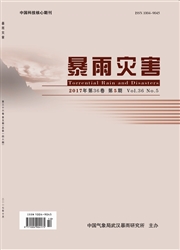

 中文摘要:
中文摘要:
利用地面加密观测资料、高空观测资料、多普勒雷达观测和雷达风场反演资料等,分析造成2010年5月6-7日华南暴雨中一次飑线的演变过程及三维结构特征。结果表明:(1)此次飑线过程发生于200 hPa高空辐散区、500 hPa高空槽后、地面准静止锋锋前暖区内,850 hPa飑线北侧为切变线,东南侧存在低空急流,中低层为中等强度垂直风切变。(2)该飑线系统初始对流单体由西风受广西大瑶山脉地形阻挡而触发。发展过程中两广交界处不断生成新单体,东移发展并入对流带,单体发展及对流带的形成与地面中尺度辐合线关系密切。(3)该飑线在形成过程中存在对流带与对流单体的锢囚过程,锢囚过程中地面辐合线及中层中气旋起组织作用,至盛期对流带东段出现弓形回波结构。强降水拖曳、雨滴蒸发冷却增强下沉气流及中层冷空气入流,造成地面冷池及后部辐散出流,促进弓形回波发展。(4)成熟期飑线系统包含弓形回波、冷池及不明显的层状云区,三维结构特征与经典飑线类似,但无涡旋对,雷暴高压也不明显。
 英文摘要:
英文摘要:
Based on the intensive surface observational data, sounding data, and Doppler radar echo and wind retrievals, the evolution and three-dimensional structure of a squall line leading to the heavy rainfall over Southern China during 6-7 May of 2010 were investigated. The results are as follows. (1) The squall line occurred in a broad region which is under the divergence area at 200 hPa, behind the upper trough at 500 hPa and in front of the quasi-stationary front. A shear line and a low-level jet existed, respectively, on the north and southeast of the squall line at 850 hPa. There was a moderate-intensity vertical wind shear at middle-low level of the squall line. (2) The sporadic convection cells in the squall line system were triggered by the blocking effect of the Dayao Mountain on the westerly wind. New convection cells were constantly generated at the border of Guangdong and Guangxi province. They moved eastward while developing and ultimately incorporated into the former eastern convection belt rapidly. Both the evolution of the convective cells and the formation of convective belt had close rela-tionship with the middle-scale convergence line near the surface. (3) During the evolution of this squall line, the convection belt and cells were occluded by the interaction of the mesoscale convergence lines near the surface and the meso-cyclone in the middle level;the eastern part of the convective line developed into a bowing echo at the mature stage. The downdraft and the inflow of cold air at middle level were en-hanced by the heavy rain drag and the water evaporation effects, which further intensified the cold pool and the divergence in the rear of the squall line, thus favored the development of the bow echo. (4) At the mature stage, bow echo, cold pool and weak stratiform cloud were evi-dent. The three-dimensional structure of this squall line was similar to that of the classic ones except for the facts that the bookend vortices were failed to appear and the thunderstorm high was weak.
 同期刊论文项目
同期刊论文项目
 同项目期刊论文
同项目期刊论文
 期刊信息
期刊信息
